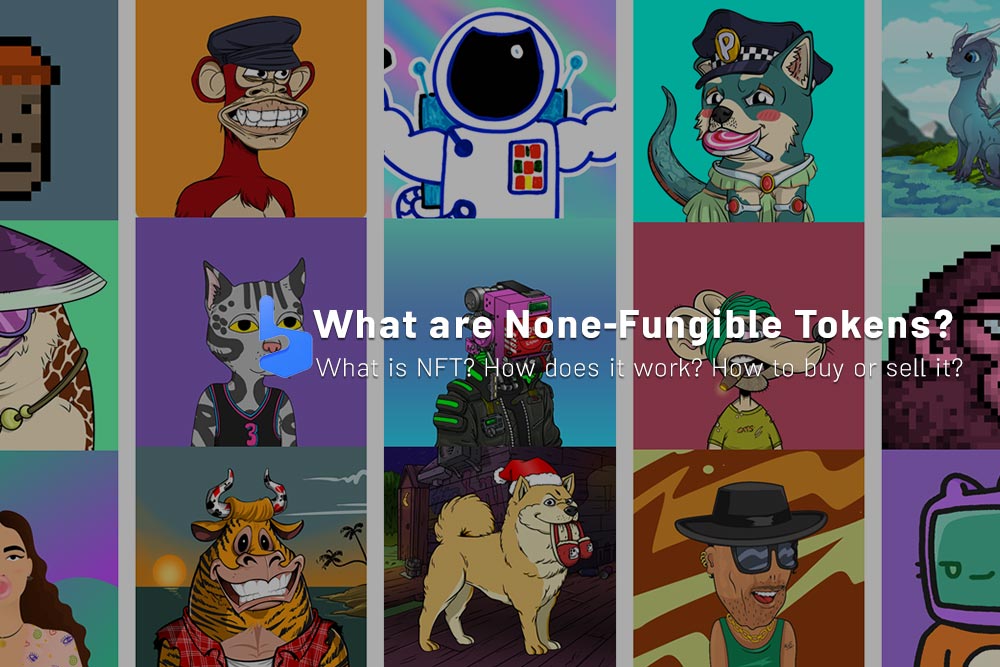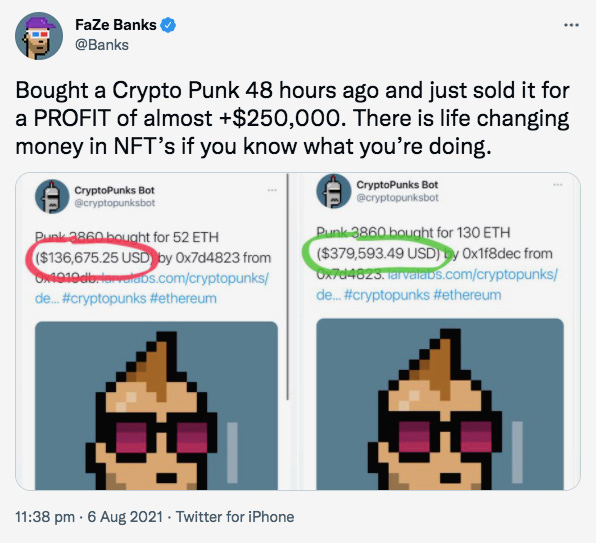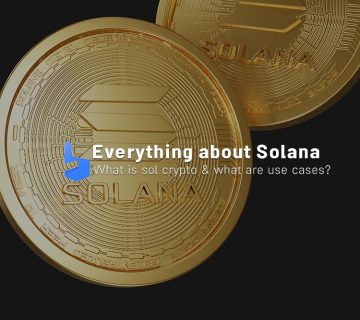What you are about to read:
The emergence of blockchain technology has paved the way for innovative concepts. NFTs, short for Non-Fungible Tokens, represent a type of digital asset that signifies ownership or authenticity of a unique item or content. In recent years, they have garnered significant attention, transforming the way digital assets, particularly in the art sector, are bought, sold, and owned. In this article, Brokerland will explore the concept of NFT, their complexities, definition, functionality, and their impact on various industries.
What is an NFT and how does it work?
An NFT is a unique digital asset that exists on a blockchain, commonly utilizing the Ethereum blockchain. Unlike cryptocurrencies such as Bitcoin or Ether, which are interchangeable and can be traded on a one-to-one basis, they are indivisible, and their value cannot be exchanged equally. Each None-Fungible Token possesses distinct characteristics that make it non-interchangeable and unique.
These tokens are created using blockchain technology, with Ethereum being the most prevalent blockchain for their creation and trading. Blockchain functions as a decentralized ledger that records the ownership history and transactions of each NFT, ensuring transparency and immutability.
One key feature of these tokens is their ability to represent both digital and physical assets. While they are primarily associated with digital art, they can also tokenize other assets such as real estate, virtual real estate in metaverses, music albums, videos, collections, and more. By tokenizing these assets, NFT provides a secure and transparent way to prove ownership, establish provenance, and facilitate transactions in the digital realm.
None-Fungible Tokens have gained considerable attention and popularity in recent years, largely due to their impact on the art market. Artists can tokenize their artworks as NFTs, allowing them to establish ownership, sell their works directly to collectors, and earn royalties through smart contracts.
Examples of None-Fungible Tokens
These tokens exist in various categories, and here are some examples:
Digital Art: NFT has achieved significant popularity in the digital art space. Examples include “Everydays: The First 5000 Days” by Beeple, sold for $69 million, and “Crossroads” by Beeple, resold for $6.6 million. These digital art pieces are unique digital content that can be tokenized as non-fungible tokens.
Collections: These tokens have opened a new realm for collections, allowing individuals to own and trade unique digital items. An early project, CryptoKitties, offers digitally collectible cats with different features. Another example is NBA Top Shot, where fans can collect and trade officially licensed highlight clips.
Virtual Real Estate and Properties: In the virtual and metaverse world, non-fungible tokens are used to demonstrate ownership of virtual land and properties. Decentraland, for instance, provides virtual land parcels that users can buy, develop, and own. These tokens enable individuals to own and monetize their virtual assets in the metaverse.
Virtual Items in Games: Non-fungible tokens are used to represent ownership of virtual items and assets in video games. For example, Axie Infinity allows players to own unique virtual creatures called Axies, which can be used for battles and breeding. Each Axie is an NFT with distinct characteristics.
NFTs have brought about a revolutionary change in how digital assets are perceived, owned, and traded across various domains.
Music and Albums: Musicians and artists use non-fungible tokens to sell their music and exclusive albums directly to their fans. For example, Kings of Leon released their latest album, “When You See Yourself,” as an NFT, allowing fans to purchase a special edition of the album. This token includes additional items such as limited edition artworks and concert perks.
Tweets and Social Media Content: Some individuals have tokenized their tweets and social media content. Jack Dorsey, the CEO of Twitter, sold his first tweet as an NFT for millions of dollars. This demonstrates the potential of these tokens to showcase ownership and origin of digital content beyond traditional media forms.
How to Buy Non-Fungible Tokens?
To purchase these tokens, you generally need to follow these general steps:
1. Set Up a Crypto Wallet
First, set up a cryptocurrency wallet that supports the blockchain on which the NFT is built. It can be a crypto wallet for Android or a hardware wallet. Ethereum is the most common blockchain for them, so wallets like MetaMask, Trust Wallet, or Coinbase Wallet are commonly used. Ensure that you secure your wallet with a strong password and follow recommended security measures.
2. Buy Cryptocurrency:
Since most transactions are done using cryptocurrency, you’ll need to acquire the relevant crypto supported by the blockchain. For Ethereum-based NFTs, you need to acquire Ether (ETH). You can purchase ETH from a crypto exchange like CoinEx, BingX, ByBit or PancakeSwap and transfer it to your wallet.
3. Choose an NFT Marketplace
Several marketplaces are available where you can browse, explore, and purchase these tokens. Some popular platforms include OpenSea, Rarible, SuperRare, and NBA Top Shot. Different marketplaces feature unique collections and artists, so find a platform that aligns with your interests.
4. Connect Your Wallet to the Marketplace
Once you’ve chosen a marketplace, you need to link your wallet or software to the marketplace. This connection allows the marketplace to interact with your wallet for transactions. Typically, this involves logging into your wallet through a browser extension or mobile app and granting permission for the connection.
5. Browse and Select NFT
Now you can explore the marketplace and browse the available collections of None-Fungible Tokens. You can search for specific artists, categories, or preferred features. Each listing provides information about the asset, including descriptions, image or video previews, prices, and any additional details provided by the creator.
6. Make Offers or Purchase NFT
After finding the token you want to buy, depending on the marketplace options, you can either make an offer or make a direct purchase. For bidding, you specify the amount you’re willing to pay, and if the seller accepts your offer, the token is transferred to your wallet. If you prefer an immediate purchase, you pay the listed price, and the NFT is instantly transferred to your wallet.
7. Confirmation and Payment
Upon choosing the buy option, you’ll usually be prompted to confirm transaction details, including the price, gas fees (transaction fees on the blockchain), and any additional terms set by the creator. Before confirming, carefully review the transaction details. After confirmation, you’ll need to pay for the NFT using the cryptocurrency available in your wallet.
Transfer of Ownership
After a successful transaction and its confirmation on the blockchain, ownership of the NFT is transferred to your wallet’s address. You can manage and view your tokens in your wallet or through the marketplace interface.
It’s essential to note that transaction fees, known as gas fees, are incurred when buying and selling these tokens. These fees cover the processing and validation of transactions on the blockchain. Gas fees can vary depending on network congestion and transaction complexity.
Remember to exercise caution and conduct thorough research when buying these tokens, including understanding the creator, terms, and associated rights. Ensure that you are purchasing from a reputable marketplace.
Can You Sell None-Fungible Token?
Yes, you can sell non-fungible tokens by listing them on a marketplace and finding interested buyers. Here’s a general outline of the selling process:
1. Listing Your NFT for Sale
Choose the token you want to sell. List it on the marketplace, specifying the sale price or accepting bids.
2. Waiting for Offers
Potential buyers will view your listing and may make offers or purchase directly.
3. Negotiating or Confirming Purchase
If offers are made, you can negotiate or accept them. Confirm transaction details and receive payment in cryptocurrency.
4. Transfer of Ownership
Once the buyer completes the purchase, the NFT ownership is transferred to their wallet.
Marketplace Fees
Keep in mind that the marketplace may charge fees for listing and successful sales. Always be mindful of the terms, rights, and conditions associated with selling NFTs. It’s crucial to follow best practices and ensure transparency in your transactions.
5. Choose a NFT Marketplace
Select a marketplace that aligns with your preferences and the type of token you want to sell. Popular marketplaces include OpenSea, Rarible, SuperRare, and NBA Top Shot.
6. Connect Your Wallet
Connect your wallet, containing the desired NFT for sale, to the marketplace. This connection allows the marketplace to interact with your wallet and access the token you want to sell.
7. Set Listing Details
Provide necessary information for your token listing, including title, descriptions, images or videos, and any additional details potential buyers may find relevant. You also need to set a price for it. Depending on the marketplace, you may have the option to choose between fixed prices or auction-style listings.
8. Confirm Listing and Pay Fees
After entering listing details, review and confirm the listing. Some marketplaces may charge fees for listing your none-fungible token, or they might ask you to pay gas fees (transaction fees on the blockchain). Before proceeding, make sure you understand and agree to the fees.
9. Wait for Buyers
Once your token is listed, it becomes visible to buyers in the marketplace. Interested buyers can browse and search for your listing. Keep in mind that finding a buyer may take some time, depending on market demand, the popularity of your NFT, and other factors.
10. Complete the Sale
When a buyer decides to make a purchase, the marketplace process is followed to complete the transaction. The buyer usually pays the listed price or, in the case of an auction-style listing, the winning bid amount. After a successful transaction, ownership of the token is transferred from your wallet to the buyer’s wallet, and you receive payment in the cryptocurrency associated with the marketplace.
Withdraw Funds
After completing the sale, depending on the marketplace and your preferences, you can either keep the funds in your wallet for future transactions or withdraw them to a decentralized or centralized cryptocurrency exchange or bank account.
The Future of NFT
Despite challenges and controversies, non-fungible tokens have shown their potential to disrupt various industries and redefine ownership in the digital age. These tokens are expected to play a significant role in the development of virtual reality (VR) and metaverse ecosystems.
Nwith their ability to tokenize virtual properties, avatar accessories, and in-game items, enable users to have real ownership and portability of their digital assets in different virtual worlds. This integration opens up opportunities for widespread experiences, virtual economies, and new forms of social interaction.
Furthermore, they have the potential to transform the education sector by providing certificates and credentials that are verifiable and immutable. By tokenizing achievements, skills, and educational documents, NFTs can increase trust and reduce fraud in the process of credential verification. Students and professionals can have a secure digital record of their educational achievements, making sharing and verifying their credentials more decentralized and accessible.
They have previously started reshaping the music industry, allowing musicians to sell unique digital albums, concert tickets, and merchandise directly to fans. This direct-to-consumer approach enables artists to establish a closer connection with their audience and earn a larger share of income from their work. Additionally, they can offer fans access to limited editions of music recordings or even exclusive behind-the-scenes content and experiences.
As augmented reality (AR) technology continues to advance, the combination of none-fungible tokens and AR holds great potential. NFTs can serve as markers or triggers for experiences, allowing users to interact with digital art, virtual objects, or information overlaid on the physical world. This integration can transform advertising, storytelling, and consumer interaction, creating personalized and immersive experiences.
Concerns have been raised regarding the environmental impact of these tokens, especially due to the energy consumption associated with blockchain transactions. However, efforts are underway to address these concerns by exploring alternative blockchain technologies with lower carbon footprints. Some projects are investigating layer-two solutions, such as sidechains and off-chain scaling solutions, to reduce environmental effects while maintaining the benefits of non-fungible tokens.
Conclusion
In conclusion, non-fungible tokens have emerged as a pioneering technology with the potential to transform various industries, particularly the art market. By providing a secure and transparent system for the ownership and trading of digital assets, they have opened up new avenues for creators, collectors, and investors. However, challenges related to environmental sustainability, copyright protection, and market volatility must be carefully addressed as the technology evolves.
As these tokens continue to evolve and find applications in virtual reality, education, music, augmented reality, and beyond, achieving a balance between innovation, adoption, and sustainability is crucial. With appropriate regulations, responsible consumption, and technological advancements, NFTs can usher in a new era of digital ownership, creativity, and economic opportunities for artists and creators worldwide.














